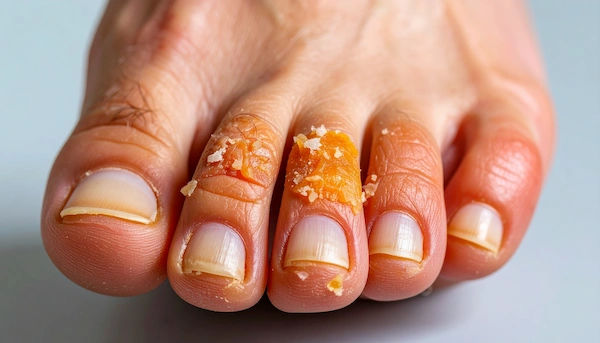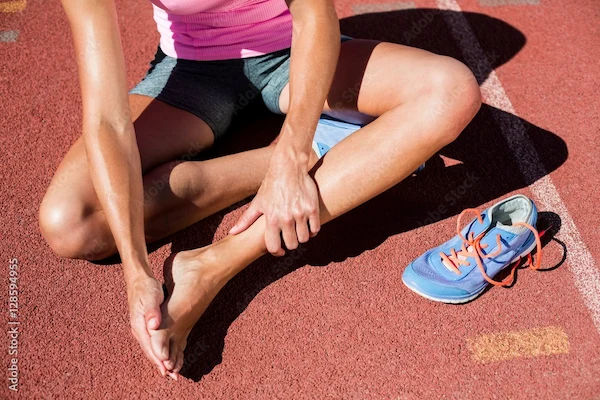Guide to Is It Hard To Treat Athletes Foot
Discover why an athlete's foot can be stubborn and learn a complete, step-by-step guide to treat, prevent, and stop it from coming back.

Written by Dr. Siri Nallapu
Reviewed by Dr. Rohinipriyanka Pondugula MBBS
Last updated on 3rd Oct, 2025

Introduction
That relentless itch, the peeling skin, the burning sensation between your toes—if you've ever battled an athlete's foot, you know the frustration. You apply the cream, the symptoms fade, but a few weeks later, they’re back with a vengeance. This leads to the burning question: is an athlete's foot genuinely hard to treat? The honest answer is: it can be, but not for the reasons you might think. The fungus that causes athlete's foot (Tinea pedis) is notoriously resilient, but the real challenge often lies in the treatment approach itself. Many people stop treatment too early, fail to address the fungal spores in their environment, or misdiagnose the condition altogether. This comprehensive guide will demystify why an athlete's foot can be such a stubborn opponent and provide a clear, actionable plan not just to treat the current infection, but to prevent it from coming back for good. We’ll cover everything from choosing the right antifungal cream to the critical hygiene habits that make all the difference.
Why an Athlete's Foot Can Be a Stubborn Foe
An athlete's foot isn't inherently difficult to kill; modern antifungals are quite effective. The hardship arises from a combination of the fungus's biology and common human error. Understanding this is the first step to successful treatment.
The Tenacious Nature of Dermatophytes
The culprits behind the athlete's foot are a group of fungi called dermatophytes. These organisms thrive in warm, dark, and moist environments—exactly like the inside of a shoe. They feed on keratin, a protein found in your skin, hair, and nails. Their resilience comes from their ability to form spores that can survive in a dormant state on surfaces like bathroom floors, shower mats, and shoes for months, waiting for the right conditions to reactivate. This is why simply applying cream to your feet is often not enough to win the war; you must also battle the spores in your environment.
Common Mistakes That Make Treatment Hard
Many well-intentioned efforts fail due to a few critical missteps:
- Stopping Treatment Too Soon: This is the number one reason for recurring athlete's foot. When the itching and redness disappear, it's tempting to stop using the cream. However, the surface-level symptoms often resolve before the underlying fungal infection is fully eradicated. Stopping early allows the remaining fungus to rebound.
- Incomplete Application: People often apply cream only to the visibly affected areas. The fungus, however, can be present on other parts of the foot without causing immediate symptoms. It's crucial to apply the medication to the entire foot, especially between all toes and on the soles.
- Re-infection from Contaminated Items: If you successfully treat your feet but then put on a pair of fungus-laden shoes or walk barefoot on a contaminated bathroom floor, you're essentially starting from scratch. Decontaminating your shoes and socks is a non-negotiable part of the process.
Consult a Dermatologist for the best advice
Your Step-by-Step Guide to Effective Treatment
A successful treatment plan is methodical and consistent. Here’s how to tackle the infection effectively.
Over-the-Counter (OTC) Antifungal Power
For most cases, OTC options are the first line of defense. Look for creams, sprays, or powders containing active ingredients like:
- Terbinafine (Lamisil): Highly effective and often works in about one week.
- Clotrimazole (Lotrimin): A broad-spectrum antifungal that typically requires two to four weeks of use.
- Miconazole (Micatin): Similar to clotrimazole, it requires a longer treatment duration.
Application Protocol: Wash and dry your feet thoroughly twice a day. Then, apply a thin layer of the antifungal medication to the entire foot, covering all skin from the ankle down. Continue this routine for the entire duration recommended on the package, even if your symptoms improve sooner—usually for at least 1-2 weeks after the skin appears normal.
When to Seek Prescription-Strength Help
If you've diligently used OTC treatments for four weeks with no improvement, or if the infection is severe (widespread, blistering, causing cracks or bleeding), it's time to see a doctor. Why won't my athlete's foot go away with OTC meds? You might have a treatment-resistant strain, a different condition like eczema or psoriasis, or a bacterial infection. A doctor can provide:
- Oral Antifungal Medications: Pills like terbinafine or itraconazole are used for severe or chronic athlete's foot that has
invaded the nails. - Stronger Topical Prescriptions: Potent creams or solutions that aren't available over-the-counter.
If your condition does not improve after trying OTC methods, consult a doctor online with Apollo24|7 for further evaluation. They can assess your situation and recommend the next steps, which may include a prescription.
Beyond Creams: The Critical Role of Foot and Environment Hygiene
Medication treats the infection on your skin, but hygiene prevents it from returning. This is the most overlooked aspect of treatment.
The Right Way to Wash and Dry Your Feet
Daily foot washing is essential, but technique matters. Use soap and water, paying special attention to the spaces between your toes. The crucial step is drying. Dermatophytes need moisture. After washing, dry your feet completely with a separate, clean towel. Don't forget between your toes—consider using a hair dryer on a cool setting for absolute dryness.
Decontaminating Your Shoes and Socks
Your footwear is a primary reservoir for fungus. Keep your feet fungus-free by properly decontaminating shoes and socks:
- Socks: Wear moisture-wicking socks (cotton or wool blends) and change them at least once a day, or more if your feet
sweat. Wash them in hot water to kill fungal spores. - Shoes: Give your shoes at least 24-48 hours to air out and dry completely between wears. Use antifungal powders or
sprays inside your shoes daily. For a deeper clean, wipe the insides with a disinfectant wipe or use UV shoe sanitisers.
Advanced Prevention: How to Stop It From Coming Back
Once you've cleared the infection, maintaining these habits is key to long-term freedom from an athlete's foot.
Choosing the Right Footwear
Opt for shoes made of breathable materials like leather or canvas instead of plastic. Whenever possible, wear open-toed sandals to allow air circulation. Avoid wearing tight, enclosed shoes for prolonged periods.
Protective Measures in Public Spaces
The fungus spreads easily in damp communal areas. Always wear waterproof sandals or flip-flops in public pools, gym
locker rooms, and communal showers. This simple habit is one of the most effective ways to prevent initial infection and re-infection.
When to Consult a Healthcare Professional
Self-treatment is appropriate for mild cases, but seek medical advice if you experience:
- No improvement after 2-4 weeks of consistent OTC treatment.
- Signs of a bacterial infection (increased redness, swelling, pain, pus, or fever).
- You have diabetes, as foot infections can lead to serious complications.
- The infection has spread to your nails (onychomycosis), which is much harder to treat.
Conclusion: Winning the Battle Against Athlete's Foot
So, is an athlete's foot hard to treat? It can be a challenging condition, but primarily when approached with a short-term mindset. The difficulty isn't usually in killing the fungus itself, but in executing a comprehensive strategy that addresses both the infection on your skin and the spores in your environment. By understanding the tenacious nature of the fungus, following a consistent and complete treatment protocol, and adopting rigorous preventative hygiene habits, you can absolutely break the cycle of recurring athlete's foot. Remember, victory lies not just in the cream you apply, but in the daily choices you make to keep your feet dry and protected. If you've tried everything and are still struggling, don't hesitate to seek professional guidance. Book a physical visit to a doctor with Apollo24|7 to get a definitive diagnosis and a personalised treatment plan to finally put an end to the itch for good.
Consult a Dermatologist for the best advice
Consult a Dermatologist for the best advice
Dr. Kavitha Killaparthy
Dermatologist
23 Years • MBBS,DIPLOMA(DERMATOLOGY,VENEREOLOGY,LEPROSY)
Hyderabad
JDS Skin & Hair Clinic, Hyderabad
Dr. Mayuri Jain
Dermatologist
11 Years • MBBS, MD Dermatology , Venereology & Leprosy
Delhi
Dr Mayuri Jain Clinic, Delhi

Dr Ekansh Shekhar
Dermatologist
10 Years • MBBS MD
Lucknow
Apollo Clinic Hazratganj, Lucknow
Dr.j Girishma
Dermatologist
6 Years • MBBS MD DERMATOLOGY
Bengaluru
Apollo Medical Center, Marathahalli, Bengaluru

Dr. Satarupa Mondal
Dermatologist
7 Years • MBBS , MD (Dermatology , Venereology & leprosy) , Diplomate (Derm.Vene.Lep)
Kolkata
Dr Satarupa Mondal, Kolkata
Consult a Dermatologist for the best advice
Dr. Kavitha Killaparthy
Dermatologist
23 Years • MBBS,DIPLOMA(DERMATOLOGY,VENEREOLOGY,LEPROSY)
Hyderabad
JDS Skin & Hair Clinic, Hyderabad
Dr. Mayuri Jain
Dermatologist
11 Years • MBBS, MD Dermatology , Venereology & Leprosy
Delhi
Dr Mayuri Jain Clinic, Delhi

Dr Ekansh Shekhar
Dermatologist
10 Years • MBBS MD
Lucknow
Apollo Clinic Hazratganj, Lucknow
Dr.j Girishma
Dermatologist
6 Years • MBBS MD DERMATOLOGY
Bengaluru
Apollo Medical Center, Marathahalli, Bengaluru

Dr. Satarupa Mondal
Dermatologist
7 Years • MBBS , MD (Dermatology , Venereology & leprosy) , Diplomate (Derm.Vene.Lep)
Kolkata
Dr Satarupa Mondal, Kolkata
More articles from Athletes foot
Frequently Asked Questions
1. What does a healing athlete's foot look like?
Signs of healing include reduced redness and itching, disappearance of blisters, and the peeling skin being replaced by new, healthy skin. The area should look and feel normal again.
2. Can I use hand sanitiser on an athlete's foot?
No, this is not recommended. Hand sanitiser is designed for bacteria, not fungi, and is far too harsh for the sensitive, often broken skin of an athlete's foot infection. It can cause significant irritation and delay healing.
3. Is the vinegar soak method effective for athlete's foot?
While some people find temporary relief, vinegar (acetic acid) is not a reliable fungicide. It may alter the skin's pH enough to mildly inhibit growth, but it is not as effective as proven OTC antifungal medications and should not be relied upon as a primary treatment.
4. How long can athlete's foot fungus live in shoes?
Fungal spores can survive in the dark, moist interior of shoes for several months, which is why disinfecting your footwear is a critical part of treatment and prevention.
5. Why does my athlete's foot keep coming back between my toes?
The space between toes is the perfect environment for fungus: warm, dark, and often moist. If treatment is stopped too soon or if feet aren't dried thoroughly, this area is the first to be re-colonised. Meticulous drying and continued preventative application of powder can help.
.webp)


